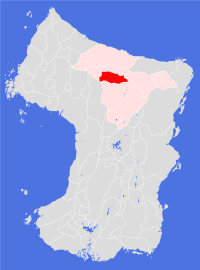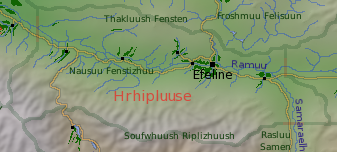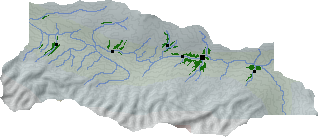Hrhipluuse

Societal ties: Ambostak
Current population: 1
Main language(s): Ramajal
Area: 156,000km²
Natural and political borders
The northern and southern borders of this Land are natural, formed by the Thakluush Fensten and the Soufwhuush Riplizhuush respectively. The Land covers the Ramuu river and its tributaries between longitudes 171.5°E and 177.1°E, including the Samaraelhuu river north of the rapids at latitude 34.8°N.
History
Efeline plantation was established in gt697, the first significant fruit of the Ambostak Age of Exploration, and grew rapidly in its first 40 orbits of existence. As new settlements and plantations came online further west, growth in the plantation stabilised and the new city settled into a slower, more laid back way of life.
The collapse of the Ramane State at the end of the eighth century was not initially beneficial to Hrhipluuse; trade along the river, which had been the mainstay of the local economy, shrunk drastically as the new Lands concentrated on building up their own internal markets. During this time the Efeline citizens embarked on a new settlement programme to extend the amount of land under cultivation. The first tea bushes arrived in the valley in gt825, where growing conditions proved to be ideal for them. Two of the new settlements, in a bold yet risky decision, decided to plant tea bushes across much of their newly prepared cultivations - a risk that has paid off spectacularly since then.

Politics and economy
Hrhipluuse produces some of the highest quality tea on the continent. Over 30 per cent of the total cultivated area is devoted to tea plantations, with the best tea being grown at elevations between 500 and 750 metres. While much of the crop is exported, a substantial quantity is consumed locally - the Hrhipluuse folk are famous for their tea drinking habit.
While tea may dominate the local economy, the Land is not entirely dependent on it for revenue. Efeline has a thriving light manufacturing sector, and a number of goods haulage enterprises are based in the city. The city also produces fine wrought iron metalwork for export, while the settlements are renowned for producing excellent goat-wool rugs - the local variety of goat produces high quality wool.
In the political arena the city dominates - over half the population lives within the city boundaries. The Land has a representative democracy, with settlements enjoying a limited form of self-determination.
Culture and other issues of interest
The local metalwork and rugmaking industries have led to the development of a distinctive artistic style known and Fenstuu - an intricate use of natural forms rendered through colour and shape, which has spread into the local architectural style. Each settlement has a preferred variant of the style, as do the different neighbourhoods of the city. In particular, a number of temples have been decorated in their local style, making tours of the temples a popular visitor activity.
The annual tea festival takes place around 30 days after the summer solstice, though more alcohol than tea is consumed during the four day celebrations.
Key natural features
The Ramuu river, flowing through the Nausuu Fenstizhuu, is notable for the number of short, fast flowing tributaries that join it, making the river more treacherous than would otherwise be expected. The northern slopes of the Soufwhuu Riplizhuu are particularly steep and the range rises to over 4,000m above sea level - for instance Mt. Ripluu is 4,610m high and Mt. Samuu is 4,080m high. By contrast, the northern hills are much lower.

Habitats
The river valley has a broad, northern valleys habitat, flanked on both sides by northern scrublands.
Plantations and settlements
Efeline Plantation is the most extensive cultivation in the Land, straddling both sides of the Ramuu river and stretching north and south along local tributaries. In addition to the city, the plantation hosts a second settlement downriver. There are three further settlements downriver from the plantation and one upriver.
Key towns and cities
Rural population: 0 (0.0% of total)